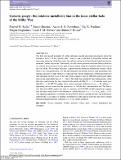Files in this item
Galactic googly : the rotation-metallicity bias in the inner stellar halo of the Milky Way
Item metadata
| dc.contributor.author | Kafle, Prajwal R. | |
| dc.contributor.author | Sharma, Sanjib | |
| dc.contributor.author | Robotham, Aaron S. G. | |
| dc.contributor.author | Pradhan, Raj K. | |
| dc.contributor.author | Guglielmo, Magda | |
| dc.contributor.author | Davies, Luke J. M. | |
| dc.contributor.author | Driver, Simon P. | |
| dc.date.accessioned | 2018-01-19T15:30:08Z | |
| dc.date.available | 2018-01-19T15:30:08Z | |
| dc.date.issued | 2017-09 | |
| dc.identifier | 252095861 | |
| dc.identifier | 02a9eda2-cbf9-4da5-8f47-08e82d2e3710 | |
| dc.identifier | 85051548830 | |
| dc.identifier | 000406844800034 | |
| dc.identifier.citation | Kafle , P R , Sharma , S , Robotham , A S G , Pradhan , R K , Guglielmo , M , Davies , L J M & Driver , S P 2017 , ' Galactic googly : the rotation-metallicity bias in the inner stellar halo of the Milky Way ' , Monthly Notices of the Royal Astronomical Society , vol. 470 , no. 3 , pp. 2959-2971 . https://doi.org/10.1093/mnras/stx1394 | en |
| dc.identifier.issn | 0035-8711 | |
| dc.identifier.other | ArXiv: http://arxiv.org/abs/1706.02301v1 | |
| dc.identifier.uri | https://hdl.handle.net/10023/12530 | |
| dc.description.abstract | The first and second moments of stellar velocities encode important information about the formation history of the Galactic halo. However, due to the lack of tangential motion and inaccurate distances of the halo stars, the velocity moments in the Galactic halo have largely remained ‘known unknowns’. Fortunately, our off-centric position within the Galaxy allows us to estimate these moments in the galactocentric frame using the observed radial velocities of the stars alone. We use these velocities coupled with the hierarchical Bayesian scheme, which allows easy marginalization over the missing data (the proper motion, and uncertainty-free distance and line-of-sight velocity), to measure the velocity dispersions, orbital anisotropy (β) and streaming motion (vrot) of the halo main-sequence turn-off (MSTO) and K-giant (KG) stars in the inner stellar halo (r ≲ 15 kpc). We study the metallicity bias in kinematics of the halo stars and observe that the comparatively metal-rich ([Fe/H] > −1.4) and the metal-poor ([Fe/H] ≤ −1.4) MSTO samples show a clear systematic difference in vrot ∼ 20-40 km s−1, depending on how restrictive the spatial cuts to cull the disc contamination are. The bias is also detected in KG samples but with less certainty. Both MSTO and KG populations suggest that the inner stellar halo of the Galaxy is radially biased i.e. σr > σθ or σϕ and β ≃ 0.5. The apparent metallicity contrariety in the rotation velocity among the halo sub-populations supports the co-existence of multiple populations in the galactic halo that may have formed through distinct formation scenarios, i.e. in situ versus accretion. | |
| dc.format.extent | 13628527 | |
| dc.language.iso | eng | |
| dc.relation.ispartof | Monthly Notices of the Royal Astronomical Society | en |
| dc.subject | Galaxy: formation | en |
| dc.subject | Galaxy: general | en |
| dc.subject | Galaxy: halo | en |
| dc.subject | Galaxy: kinematics and dynamics | en |
| dc.subject | QB Astronomy | en |
| dc.subject | QC Physics | en |
| dc.subject | 3rd-DAS | en |
| dc.subject.lcc | QB | en |
| dc.subject.lcc | QC | en |
| dc.title | Galactic googly : the rotation-metallicity bias in the inner stellar halo of the Milky Way | en |
| dc.type | Journal article | en |
| dc.contributor.institution | University of St Andrews. School of Physics and Astronomy | en |
| dc.identifier.doi | 10.1093/mnras/stx1394 | |
| dc.description.status | Peer reviewed | en |
| dc.identifier.url | http://arxiv.org/abs/1706.02301v1 | en |
This item appears in the following Collection(s)
Items in the St Andrews Research Repository are protected by copyright, with all rights reserved, unless otherwise indicated.

